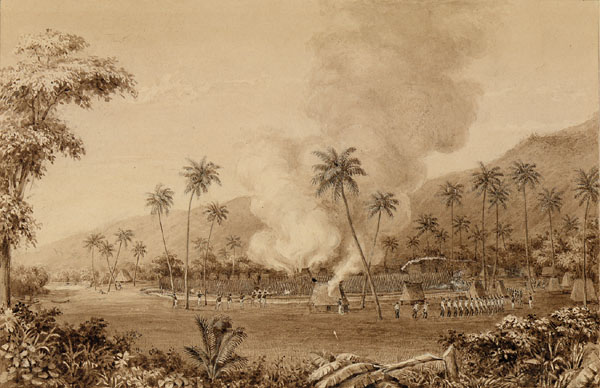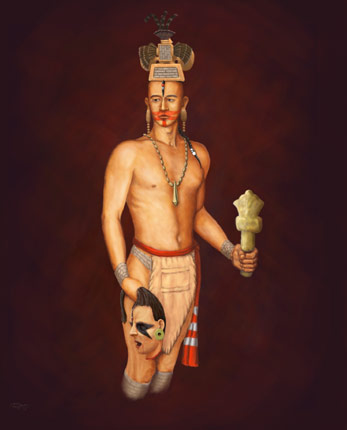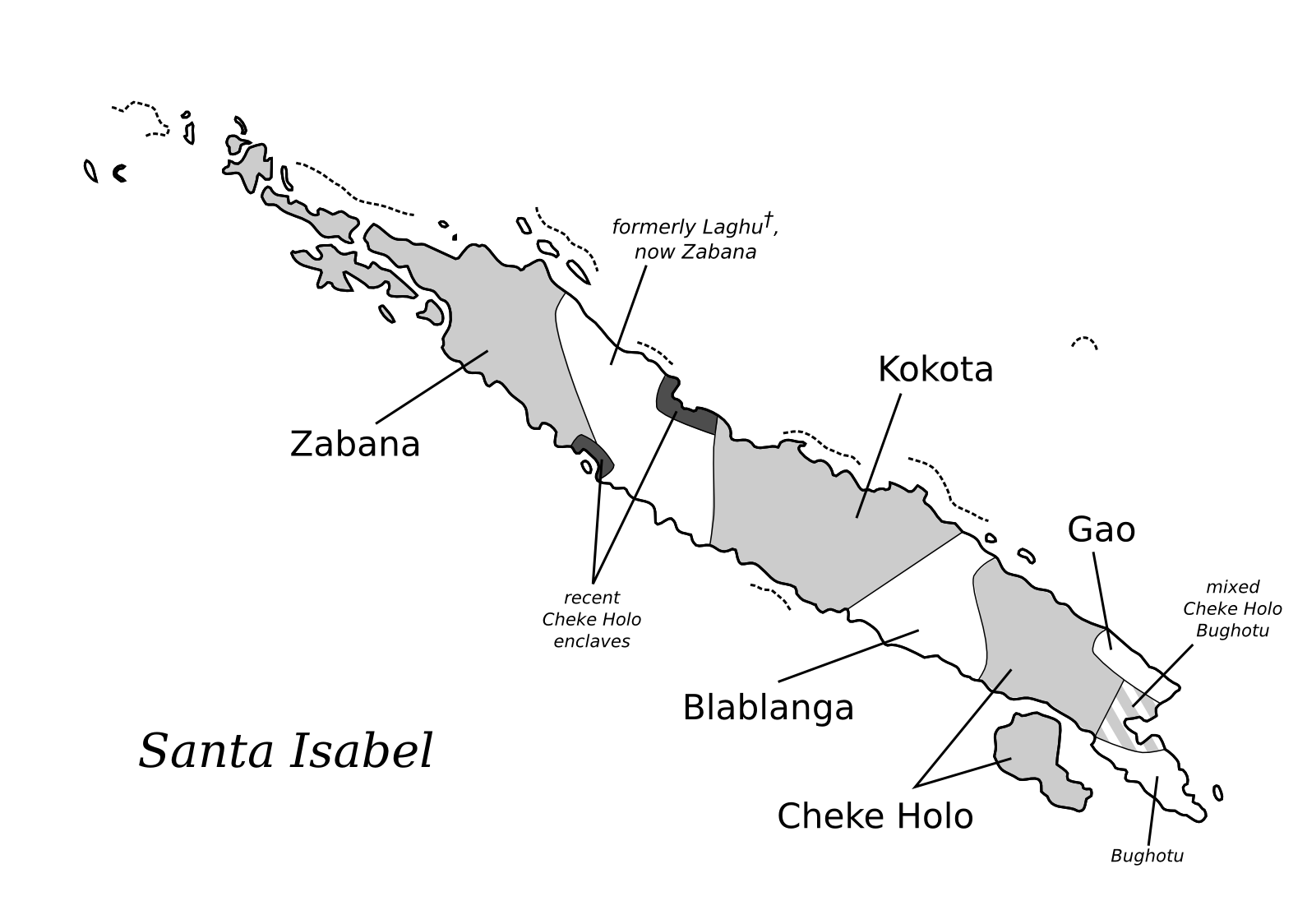|
New Georgia
New Georgia, with an area of , is the largest of the islands in Western Province, Solomon Islands, and the 200th-largest island in the world. Geography New Georgia island is located in the New Georgia Group, an archipelago including most of the other larger islands in the province. The island measures approximately long by wide. New Georgia forms part of the southern boundary of the New Georgia Sound. Kolombangara lies across the Kula Gulf to the west, Choiseul to the northeast, Vangunu is to the southeast, and Rendova to the southwest, across the Blanche Channel. New Georgia is a volcanic island, surrounded in some places by a coral reef. The highest point is Mount Masse, with an elevation of . The climate is wet and tropical, and the island is subject to frequent cyclones. New Georgia is covered with dense vegetation, in the marshy areas mangroves are located. Population The population of the island was 19,312 in 1999. Most of the population resides on the so ... [...More Info...] [...Related Items...] OR: [Wikipedia] [Google] [Baidu] |
New Georgia Group
The New Georgia Islands are part of the Western Province (Solomon Islands), Western Province of Solomon Islands. They are located to the northwest of Guadalcanal. The larger islands are mountainous and covered in rain forest. The main islands are New Georgia, Vella Lavella, Kolombangara (a dormant volcano), Ghizo Island, Ghizo, Vangunu, Rendova and Tetepare. They are surrounded by coral reefs and include the largest saltwater lagoon in the world: Marovo lagoon. Another famous location is Kennedy Island where the future United States president, John F. Kennedy, spent three days stranded during World War II. Several of the islands were New Georgia Campaign, scenes of fighting in the war. The main towns are Gizo, Solomon Islands, Gizo, Munda (Solomon Islands), Munda and Noro, Solomon Islands, Noro. The main industries are forestry and fishing. One of the smaller New Georgia islands, Ranongga, was lifted three metres (10 ft.) out of the Pacific Ocean by the 2007 Solomon Islan ... [...More Info...] [...Related Items...] OR: [Wikipedia] [Google] [Baidu] |
Solomon Islands
Solomon Islands is an island country consisting of six major islands and over 900 smaller islands in Oceania, to the east of Papua New Guinea and north-west of Vanuatu. It has a land area of , and a population of approx. 700,000. Its capital, Honiara, is located on the largest island, Guadalcanal. The country takes its name from the wider area of the Solomon Islands (archipelago), which is a collection of Melanesian islands that also includes the Autonomous Region of Bougainville (currently a part of Papua New Guinea), but excludes the Santa Cruz Islands. The islands have been settled since at least some time between 30,000 and 28,800 BCE, with later waves of migrants, notably the Lapita people, mixing and producing the modern indigenous Solomon Islanders population. In 1568, the Spanish navigator Álvaro de Mendaña was the first European to visit them. Though not named by Mendaña, it is believed that the islands were called ''"the Solomons"'' by those who later r ... [...More Info...] [...Related Items...] OR: [Wikipedia] [Google] [Baidu] |
Blanche Channel
Blanche Channel is a strait and waterway in the Western Province of the Solomon Islands. It lies between New Georgia Island and Vangunu island on the northeast, and Rendova Island and Tetepare Island on the southwest. The channel opens to the Solomon Sea The Solomon Sea is a sea located within the Pacific Ocean. It lies between Papua New Guinea and Solomon Islands. Many major battles were fought there during World War II. Extent The International Hydrographic Organization defines the limits of ... at both its east and west ends. See also * References Straits of the Solomon Islands Western Province (Solomon Islands) {{Solomons-geo-stub ... [...More Info...] [...Related Items...] OR: [Wikipedia] [Google] [Baidu] |
Methodism
Methodism, also called the Methodist movement, is a group of historically related Christian denomination, denominations of Protestantism, Protestant Christianity whose origins, doctrine and practice derive from the life and teachings of John Wesley. George Whitefield and John's brother Charles Wesley were also significant early leaders in the movement. They were named ''Methodists'' for "the methodical way in which they carried out their Christian faith". Methodism originated as a Christian revival, revival movement within the 18th-century Church of England and became a separate denomination after Wesley's death. The movement spread throughout the British Empire, the United States, and beyond because of vigorous Christian mission, missionary work, today claiming approximately 80 million adherents worldwide. Wesleyan theology, which is upheld by the Methodist churches, focuses on sanctification and the transforming effect of faith on the character of a Christians, Christian ... [...More Info...] [...Related Items...] OR: [Wikipedia] [Google] [Baidu] |
British Solomon Islands
The British Solomon Islands Protectorate was first declared over the southern Solomons in 1893, when Captain Gibson, R.N., of , declared the southern islands a British protectorate. Other islands were subsequently declared to form part of the Protectorate. Establishment and addition of islands After the Anglo-German Declarations about the Western Pacific Ocean, the Protectorate was first declared over the southern Solomons in 1893. The formalities in its establishment were carried out by officers of the Royal Navy, who hoisted the British flag and read Proclamations on twenty-one islands. In April 1896, Charles Morris Woodford was appointed as an Acting Deputy Commissioner of the British Western Pacific Territories. From 30 May to 10 August 1896, HMS ''Pylades'' toured through the Solomon Islands archipelago with Woodford, who had been sent to survey the islands and to report on the economic feasibility of the British Solomon Islands Protectorate. On 29 September 189 ... [...More Info...] [...Related Items...] OR: [Wikipedia] [Google] [Baidu] |
Punitive Expedition
A punitive expedition is a military journey undertaken to punish a political entity or any group of people outside the borders of the punishing state or union. It is usually undertaken in response to perceived disobedient or morally wrong behavior by miscreants, as revenge or corrective action, or to apply strong diplomatic pressure without a formal declaration of war (e.g. surgical strike). In the 19th century, punitive expeditions were used more commonly as pretexts for colonial adventures that resulted in annexations, regime changes or changes in policies of the affected state to favour one or more colonial powers. Stowell (1921) provides the following definition: When the territorial sovereign is too weak or is unwilling to enforce respect for international law, a state which is wronged may find it necessary to invade the territory and to chastise the individuals who violate its rights and threaten its security. Historical examples *In the 5th century BC, the Achaeme ... [...More Info...] [...Related Items...] OR: [Wikipedia] [Google] [Baidu] |
Headhunting
Headhunting is the practice of hunting a human and collecting the severed head after killing the victim, although sometimes more portable body parts (such as ear, nose or scalp) are taken instead as trophies. Headhunting was practiced in historic times in parts of Europe, East Asia, Oceania, Southeast Asia, South Asia, Mesoamerica, West and Central Africa. The headhunting practice has been the subject of intense study within the anthropological community, where scholars try to assess and interpret its social roles, functions, and motivations. Anthropological writings explore themes in headhunting that include mortification of the rival, ritual violence, cosmological balance, the display of manhood, cannibalism, dominance over the body and soul of his enemies in life and afterlife, as a trophy and proof of killing (achievement in hunting), show of greatness, prestige by taking on a rival's spirit and power, and as a means of securing the services of the victim as ... [...More Info...] [...Related Items...] OR: [Wikipedia] [Google] [Baidu] |
Roviana
Roviana is a member of the North West Solomonic branch of Oceanic languages. It is spoken around Roviana and Vonavona lagoons at the north central New Georgia in the Solomon Islands. It has 10,000 first-language speakers and an additional 16,000 people mostly over 30 years old speak it as a second language (Raymond 2005). In the past, Roviana was widely used as a trade language and further used as a lingua franca especially for church purposes in the Western Province but now it is being replaced by the Solomon Islands Pijin. Few published studies on Roviana language include: Ray (1926), Waterhouse (1949) and Todd (1978) contain the syntax of Roviana language. Corston-Oliver (1996 & 2002) discuss about the ergativity in Roviana. Todd (2000) and Ross (1988) discuss the clause structure in Roviana. Schuelke (2020) discusses grammatical relations and syntactic ergativity in Roviana. Phonology and orthography Consonants The Roviana alphabet is based on the Latin alphabet and co ... [...More Info...] [...Related Items...] OR: [Wikipedia] [Google] [Baidu] |
Kalikoqu
The Kalikoqu are an ethnic Melanesian tribe who are concentrated in the New Georgia island of the Solomon Islands. Prior to European colonization, they resided in the eastern side of the western Roviana lagoon and established the concept of the right to property by interlinking it with marriage. Before, during and after the British Empire's establishment of the Solomon Islands Protectorate in the late Victorian era, the Kalikoqu were greatly expanded by neighboring Melanesian tribes immigrating to the Solomon Islands interior. History There were several distinct Melanesian tribes which inhabited the Roviana lagoon region and the coast of the New Georgia island during the nineteenth century, consisting of the Taghosaghe, Lio Zuzuloqo, Vuragare, and Koloi people respectively. In September 1891, several Kalikoqu tribesmen killed a European trader operating on Uki Island named Fred Howard. In response, the Royal Navy warship HMS ''Royalist'' launched a punitive expedition agains ... [...More Info...] [...Related Items...] OR: [Wikipedia] [Google] [Baidu] |
Oceanic Languages
The approximately 450 Oceanic languages are a branch of the Austronesian languages. The area occupied by speakers of these languages includes Polynesia, as well as much of Melanesia and Micronesia. Though covering a vast area, Oceanic languages are spoken by only two million people. The largest individual Oceanic languages are Eastern Fijian with over 600,000 speakers, and Samoan with an estimated 400,000 speakers. The Gilbertese (Kiribati), Tongan, Tahitian, Māori, Western Fijian and Tolai ( Gazelle Peninsula) languages each have over 100,000 speakers. The common ancestor which is reconstructed for this group of languages is called Proto-Oceanic (abbr. "POc"). Classification The Oceanic languages were first shown to be a language family by Sidney Herbert Ray in 1896 and, besides Malayo-Polynesian, they are the only established large branch of Austronesian languages. Grammatically, they have been strongly influenced by the Papuan languages of northern New Guinea, ... [...More Info...] [...Related Items...] OR: [Wikipedia] [Google] [Baidu] |
Northwest Solomonic Languages
The family of Northwest Solomonic languages is a branch of the Oceanic languages. It includes the Austronesian languages of Bougainville and Buka in Papua New Guinea, and of Choiseul, New Georgia, and Santa Isabel (excluding Bugotu) in Solomon Islands. The unity of Northwest Solomonic and the number and composition of its subgroups, along with its relationship to other Oceanic groups, was established in pioneering work by Malcolm Ross. Languages Northwest Solomonic languages group as follows: * Nehan – North Bougainville linkage ** Nehan (Nissan) **Saposa–Tinputz: Hahon, Ratsua, Saposa (Taiof)– Teop, Tinputz **Buka: Halia– Hakö, Petats ** Papapana ** Solos * Piva–Bannoni family: Piva (Lawunuia), Bannoni * Mono–Uruavan family: Mono-Alu, Torau, Uruava *Choiseul linkage: Babatana (including Sisingga)– Ririo, Vaghua– Varisi *New Georgia – Ysabel family **New Georgia linkage: Simbo (Simbo Island), Roviana– Kusaghe, Marovo, Hoava, Vangunu ... [...More Info...] [...Related Items...] OR: [Wikipedia] [Google] [Baidu] |


.jpg)


